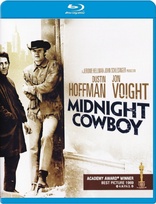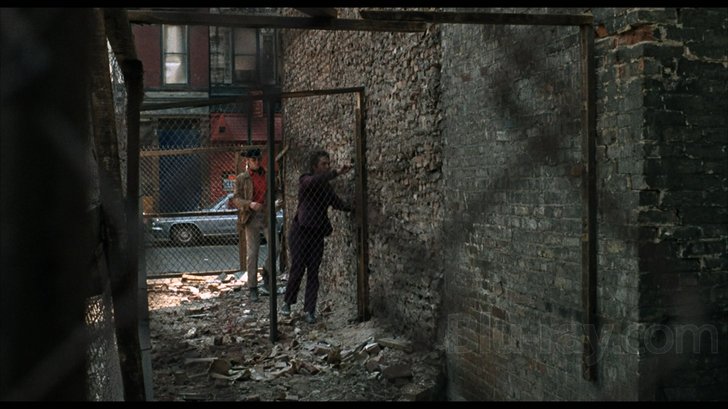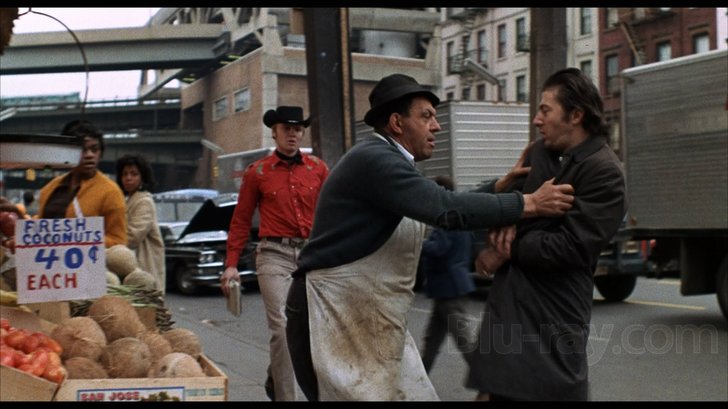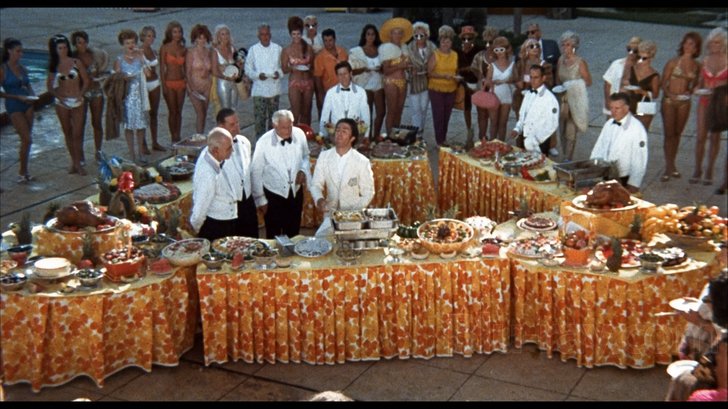Midnight Cowboy Blu-ray Movie
HomeMidnight Cowboy Blu-ray Movie 
Metro-Goldwyn-Mayer | 1969 | 113 min | Rated R | May 29, 2011
Movie rating
8 | / 10 |
Blu-ray rating
| Users | 3.1 | |
| Reviewer | 3.5 | |
| Overall | 3.5 |
Overview
Midnight Cowboy (1969)
A naive hustler travels from Texas to New York to seek personal fortune but, in the process, finds himself a new friend.
Starring: Dustin Hoffman, Jon Voight, Sylvia Miles, John McGiver, Barnard HughesDirector: John Schlesinger
| Drama | 100% |
Specifications
Video
Video codec: MPEG-4 AVC
Video resolution: 1080p
Aspect ratio: 1.85:1
Original aspect ratio: 1.85:1
Audio
English: DTS-HD Master Audio 5.1 (48kHz, 24-bit)
Spanish: Dolby Digital 2.0 Mono (256 kbps)
French: DTS 5.1 (48kHz, 24-bit)
Italian: DTS 5.1
German: DTS 5.1
Hungarian: Dolby Digital 2.0
Spanish: DTS 5.1 (48kHz, 24-bit)
Subtitles
English SDH, French, German, Italian, Japanese, Portuguese, Spanish, Danish, Dutch, Finnish, Greek, Hungarian, Mandarin (Traditional), Norwegian, Romanian, Swedish
Discs
50GB Blu-ray Disc
Single disc (1 BD)
Playback
Region free
Review
Rating summary
| Movie | 5.0 | |
| Video | 3.5 | |
| Audio | 3.5 | |
| Extras | 4.0 | |
| Overall | 3.5 |
Midnight Cowboy Blu-ray Movie Review
In Rough Shape, but Still a Classic
Reviewed by Michael Reuben June 21, 2011Most movie fans have heard of Midnight Cowboy, and many recognize its most famous line
("I'm walkin' here!"). But how many have seen it from start to finish? It was a fluke that any
studio made it in 1969, leaving the creative team complete freedom to do as they wished. Today
no studio would touch it. As for commercial success, who knows? On its initial release, the film
had the advantage both of edgy subject matter and of techniques, especially in cinematography
and editing, that were sufficiently new to American audiences that they grabbed you by the
throat. When the lights came up, you knew you'd just seen something unique, and you walked
out dazed. I remember the sensation vividly.
Today, Midnight Cowboy has acquired novelty of a different kind. Its immersive style of
emotional drama has been largely abandoned by Hollywood, while independent film is now
dominated by young filmmakers who have been told to "write what you know", which is why so
many indie films feature sensitive, artistic protagonists coming of age. Rarely does a film focus
on the down-and-out on society's periphery. (Courtney Hunt's Frozen
River and Debra Granik's
Winter's Bone are rare exceptions.) The two
protagonists of Midnight Cowboy are born losers.
One of the film's many achievements is to make audiences care deeply about them.

"I'm walkin' here!"
Texas native Joe Buck (Jon Voight, in the role that made him a star) boards a bus for New York City. He leaves behind the grandmother who raised him, now deceased, and a pack of bad memories, which rear up throughout the film, often in jagged black-and-white. Joe's purpose? To get rich as a stud for hire to all the bored, wealthy older women in Manhattan. It's unclear why Joe thinks this is a sound business plan, but hints emerge from his recollected past, in which a local girl named Annie (Jennifer Salt) figures prominently.
Joe checks into a cheap Times Square hotel and goes trawling for trade in full cowboy regalia. He quickly discovers that he has no idea what he's doing, especially after an encounter with one Park Avenue resident (Sylvia Miles, Oscar-nominated for six memorable minutes of screen time). As Joe walks along 42nd Street, it slowly dawns on him that all the clients patronizing guys dressed as cowboys are gay men.
Then Joe meets Enrico "Ratso" Rizzo (Dustin Hoffman), a filthy vagrant with a bad leg and a foul mouth. Their relationship is the core of the film. The first thing Ratso does is teach Joe a lesson in trust. (The sequence involves a remarkable performance by John McGiver in a role best left for the viewer to discover.) Later, when they cross paths again, Joe is on a downward spiral, broke and locked out of his hotel. Ratso takes him in and lets Joe stay in the squalid tenement that Ratso inhabits rent-free, hoping to keep one step ahead of the wrecking ball. Using all the petty cons he's mastered over the years, Ratso tries to connect Joe with prospective clients and dreams of becoming wealthy off Joe's skills and retiring to Florida. But the dreams are short-lived, and the two roommates quickly have nothing but each other as they face a long, cold winter with no money and no prospects. (A chance encounter leads Joe to a possible breakthrough with Shirley, played by Brenda Vaccaro, but the opportunity is short-lived.)
Midnight Cowboy is typically described as the story of a friendship, which it is, and Hoffman and Voight play it with a depth and authenticity rarely seen on screen. (Much of their dialogue was developed through improvisation in rehearsal, with screenwriter Waldo Salt recording everything, then distilling the best bits.) But the film is also the story of Joe Buck learning to accept himself, by an unexpected and roundabout path. Having fled to a fairytale land that exists only in his head, Joe discovers that he can't outrun his traumatic past. Not only do bad memories keep surfacing, but the only person with whom Joe is able to make an emotional connection is someone who is very much his own reflection, though in a distorted fun-house mirror. Ratso may not look like Joe, but he shares Joe's essential nature; both of them live on society's fringes, have no family, disdain ordinary work, are wildly impractical, dream of a fanciful and luxurious life in a place they've only imagined, and are badly crippled (though Joe's impediment is purely interior). It's not an accident that mirrors and other reflective surfaces are woven throughout the film's visual design, right up to the last shot. But director John Schlesinger does this so matter-of-factly - and Hoffman and Voight hold your attention so thoroughly - that the effect is subliminal, at least until after several viewings.
By the end of the film, Joe has reached some sort of turning point, and there's a specific scene where you can feel it happening. But no one can say for certain what lies ahead of him. Schlesinger was well-known for his dislike of tidy endings, even if he risked being less commercial. In the case of Midnight Cowboy, it doesn't seem to have hurt the film's box office performance.
Both Voight and Hoffman were nominated for best actor Oscars, but lost to John Wayne (for True Grit). Still, the film gave Voight a career and prevented Hoffman from being typecast after The Graduate. Screenwriter Salt, a formerly blacklisted writer, received the sweet vindication of an Oscar for adapting James Leo Herlihy's novel. Director Schlesinger, making his first film in America, was so certain he had no chance of winning that he stayed in London and had to learn by telephone that he'd been named best director. Producer Jerome Hellman was there to pick up the statue for best picture, the only one ever awarded to a film rated X, due to its sexual frankness (the MPAA later relented, though not without a fight).
Midnight Cowboy Blu-ray Movie, Video Quality 

From the description and screenshots, this appears to be the same transfer and encode featured on
the region-free UK Blu-ray released in May 2011. (The
extras and most of the audio and subtitle
options are also identical.) As noted in the previous review, the source material is far from
pristine, with numerous instances of dust, small scratches and other analogue wear-and-tear.
Some of the worst problems occur during the opening title sequence, because the titles would
have been superimposed by optical printing in that era, thereby locking in any dirt or damage.
Cinematographer Adam Holender reportedly oversaw a restoration for the film's 25th
anniversary, but that was most likely performed photochemically, given the state of digital
imaging at the time. What Midnight Cowboy needs is a digital restoration comparable to the work
done on the Godfather trilogy. Whether MGM's
precarious finances will support such an effort is
doubtful.
Even with digital restoration, however, Midnight Cowboy would remain a grainy film, as it is on
this Blu-ray. As DP Holender notes in the "After Midnight" documentary, much of the film was
shot with deliberate underexposure to obtain a particular pallette. With then-contemporary film
stocks and lenses, underexposure could not help but accentuate the grain, and even with current
digital tools, there is only so much that can be done without altering the intended look. It should
be remembered that in 1969 no one sat in a movie theater complaining about "grainy" images.
You watched what was on the screen and experienced the image that was there. It's only as a
result of high-resolution images on home video that terms like "grainy", "desaturated", "vibrant",
"razor-sharp", etc. have acquired a status as value judgments instead of being purely descriptive.
The AVC-encoded image on the Midnight Cowboy Blu-ray is extremely grainy compared to any
contemporary production, but once your eye adjusts to it, you realize that there is plenty of fine
detail to be observed in the image - detail that wouldn't be there if the grain were recklessly
stripped away with noise-reduction software. Detail is essential here, both for the increasingly
appalling degrees of squalor in which Joe is forced to live and for the bizarre, almost decadent
surroundings into which he gets a peek from time to time, whether uptown at the homes of
prospective clients or downtown at a Warhol-like party.
Some scenes are notably less grainy, especially the scenes in Ratzo's Florida reverie. Holender
notes in the documentary that these scenes used overexposure, which also accounts for their
intense colors. The New York scenes tend to be desaturated and cold, although certain colors
stand out, especially in Joe's inappropriately flamboyant wardrobe.
Black levels are generally good, although some crushing is evident in night scenes. Here again,
underexposure is no doubt the cause.
Midnight Cowboy Blu-ray Movie, Audio Quality 

The 2006 "collector's edition" two-disc DVD set featured a newly created 5.1 track, plus the original mono track. Only the 5.1 track appears on the Blu-ray, in DTS lossless. As 5.1 remixes go, this one is conservative and reasonably effective. It stays in front and does almost nothing with the surrounds. Dialogue occasionally moves left or right, but generally remains in the center. As is often the case, the music is the chief beneficiary of the remix, with the Nilsson rendition of "Everybody's Talkin'" sounding especially vivid and John Barry's haunting ballad for harmonica hovering over the proceedings like both an anthem and a dirge.
Midnight Cowboy Blu-ray Movie, Special Features and Extras 

As with other recent MGM discs too numerous to list, Fox has mastered this title with no main
menu but with BD-Java, omitting the ability to set bookmarks. No BDJ-encoded disc should ever
lack this capability. BDJ prevents the user from stopping playback and starting from the same
position, and bookmarking is the only workaround. Its omission is inexcusable.
With the exception of a photo gallery, all of the features have been ported over from the 2006
"collector's edition" two-disc DVD set.
- Commentary with Producer Jerome Hellman: Recording his commentary for the 35th
anniversary of the film, Hellman begins by regretfully acknowledging that he is the only
surviving member of the principal creative trio behind the camera. (Salt died in 1987,
Schlesinger in 2003.) Despite the passage of years, Hellman has detailed recall about the origin
of various sequences and various experiences on location, including locations that no longer
exist. He is also one of the sources for the contrary version of the famous "I'm walking here!"
scene, which, according to Hoffman, was an improv. Hellman maintains that the scene was
scripted, planned and carefully rehearsed.
Pauses occur occasionally, as Hellman becomes absorbed in the film. It's clear that he's still moved by it, even after countless viewings over three and a half decades. - After Midnight: Reflecting on a Classic 35 Years Later (SD; 1.78:1, enhanced; 29:59): This is an informative and engaging documentary on the making of the film. Although their memories are obviously colored by the subsequent success of the project, the interviewees have vivid recollections and intense feelings. Participants include Voight, Hoffman, Miles, Jennifer Salt, Hellman, Holender, Barry, Bob Balaban (it was his first film) and photographer Michael Childers, who was Schlesinger's partner during the production and until his death.
- Controversy and Acclaim (SD; 1.78:1, enhanced; 10:09): Many of the same interviewees discuss the MPAA's decision to slap an X rating on the film, which was the predecessor to the current NC-17. Hellman describes with obvious satisfaction how, after the film won best picture, the ratings board offered to change the rating to an R, if Hellman and Schlesinger would simply remove one frame, so that they could say it had been "recut". The producer and director refused, and the board caved.
- Celebrating Schlesinger (SD; 1.78:1, enhanced; 9:36): Numerous commentators share their thoughts about the director. Interviewees include Voight, Hoffman, Salt, Childers, Holender, Balaban, Barry, Hellman, Leonard Maltin, William Devane, Kiefer Sutherland, Robert Evans, Francis Ford Coppola and Richard Gere.
Midnight Cowboy Blu-ray Movie, Overall Score and Recommendation 

Midnight Cowboy is a classic and a masterpiece. Unfortunately, unless someone is willing to
invest significant effort and money in a major restoration, this Blu-ray from Fox/MGM is
probably the best it's going to look. Short of Criterion gaining the rights to undertake a new
version, it seems unlikely that this one will be improved upon anytime soon. I therefore
recommend it, with appropriate caveats, because the film is well worth your time.
Similar titles
Similar titles you might also like

My Own Private Idaho
1991

Scarecrow
1973

Starlet
2012

I, Daniel Blake
2016

The Big Chill
1983

Is Anybody There?
2008

Withnail and I
1987

Easy Rider
1969

While We're Young
2014

Prince Avalanche
2013

Faces
1968

Model Shop
Limited Edition to 3000
1969

The Life and Death of Colonel Blimp
1943

Two-Lane Blacktop
1971

The Master
2012

Medium Cool
1969

The Florida Project
2017

Moonlight
2016

Certain Women
2016

McCabe & Mrs. Miller 4K
1971
